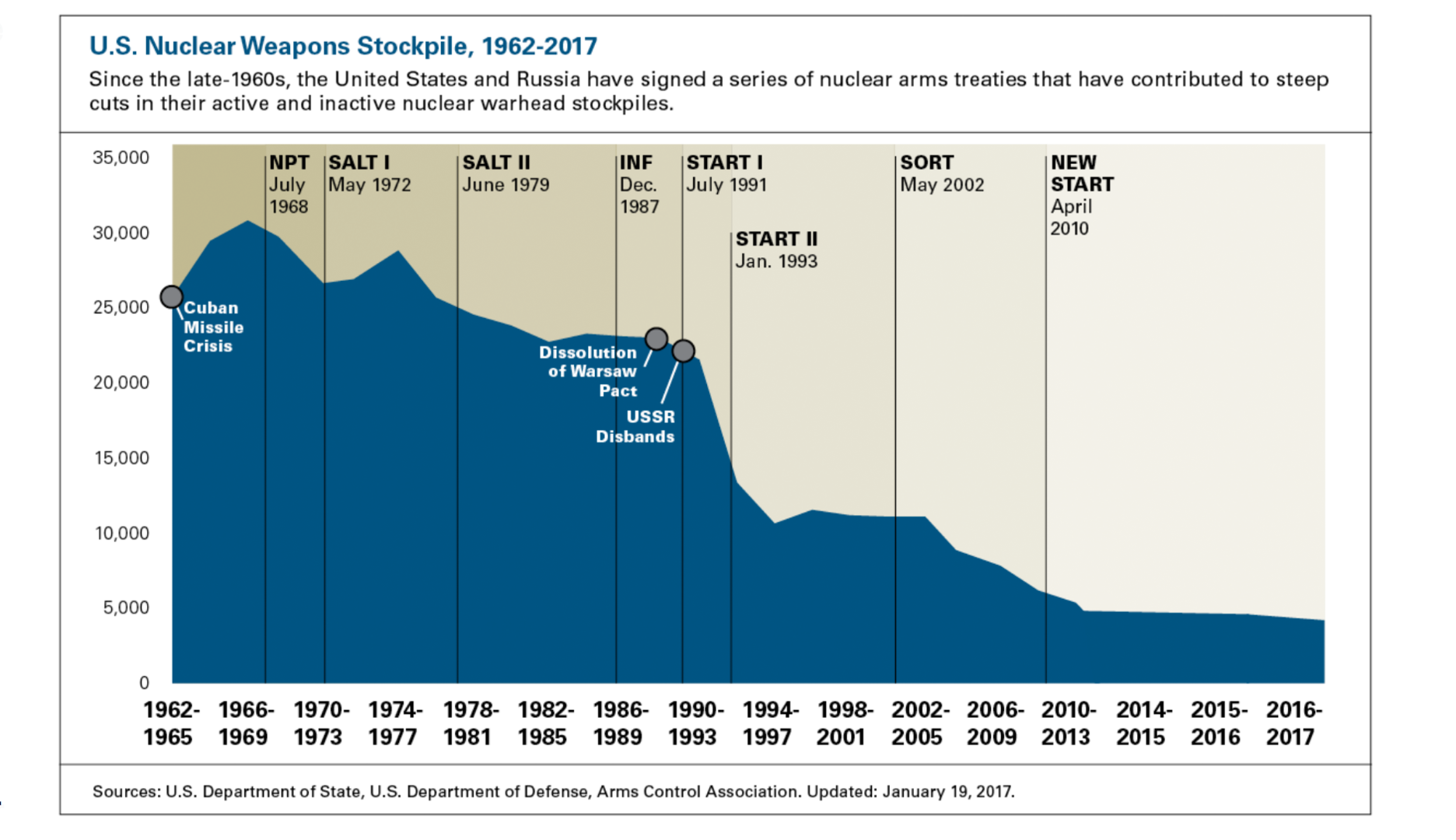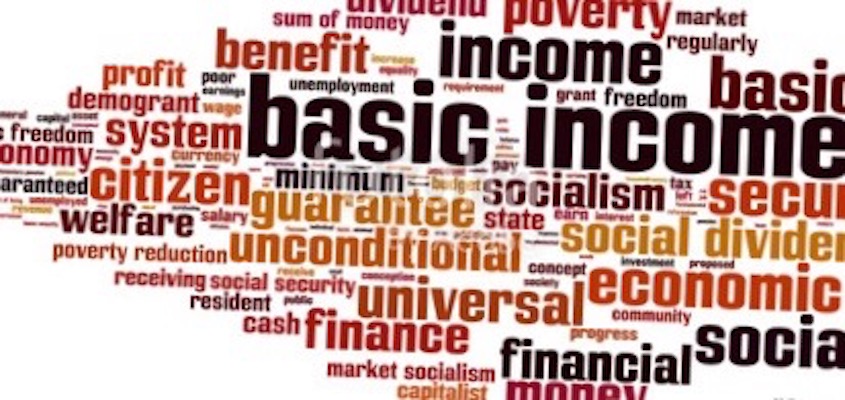Wel is
zeker dat het raketschild dat de VS heeft gebouwd in Polen en
Roemenië, NB aan de 'westelijke voordeur' van Rusland, raketten
bevat die wel waren verboden door het INF-verdrag...... Middels
smerige opzet van de VS, immers het bewuste raketschild zou Europa
beschermen tegen raketten uit Iran, dook de VS met dat schild onder het
INF-verdrag......
Alsof
Iran de behoefte heeft om andere landen aan te vallen, laat staan de
EU landen van Europa...... De schandalige truc is dat de VS deze
raketten, die een bereik hebben tot 5.000 kilometer, letterlijk binnen een mum van tijd kan voorzien van meerdere kernkoppen (per raket) en daarmee grote
Russische steden als Moskou en Sint Petersburg kan aanvallen...... Ga maar na wat de VS zou zeggen en doen als
Rusland een dergelijk raketschild in Mexico zou bouwen...... Zie de
Cubacrisis van oktober 1962, ofwel Rusland zou gedwongen worden te
stoppen met de bouw daar de VS anders een kernoorlog zou beginnen
tegen Rusland, zoals dit bijna het geval was tijdens die
Cubacrisis......
Over het
beginnen van een kernoorlog gesproken: al onder Nobelprijs voor de
Vrede winnaar Obama, liet de VS weten dat het zich het recht voorbehoudt gebruik te maken van
kernwapens bij een eerste aanval op een ander land.,..... Dit terwijl na het eerst
gebruik van atoombommen door de VS op de Japanse steden Hiroshima en Nagasaki, augustus 1945 (een oorlogsmisdaad van een schandalig formaat), kernwapens werden gezien als
afschrikkingswapen, ofwel alleen te gebruiken als de VS (en andere kernwapenstaten), zelf werd
aangevallen met kernwapens...... De Trump administratie heeft deze
verandering 'van inzicht' door 'vredesduif Obama' ingevoerd herhaald en ook Groot-Brittannië, nog
onder hare kwaadaardigheid en premier May, stelde zich op deze lijn....... Toen
Rusland een aantal maanden later hetzelfde liet weten waren de
westerse politici en de reguliere westerse media woedend, zonder ook maar met één
woord te reppen over de stappen van Obama en May.........
Zoals
gezegd het is zeker dat de VS het START-verdrag niet zal verlengen en
daarmee zal het budget van de VS voor kernwapenvernieuwing
waarschijnlijk zelfs verdriedubbelen......
Het
volgende artikel werd vandaag gepubliceerd op RT Duitsland en gaat
verder in op de gevolgen van het niet nakomen van het
START-verdrag voor de VS en haar 'schatkist' (gevuld met lucht,
Ap)...... Hierin o.a. ook aandacht voor China dat zich niet wenst te
verbinden aan kernwapenverdragen en stelt dat de VS en Rusland eerst hun
kernwapenvoorraad sterk terug moeten brengen.
Falls New START ausläuft: US-Atomwaffenbudget könnte sich verdreifachen
29.08.2020 • 12:53 Uhr
Moskau
möchte den New-START-Vertrag verlängern, aber nicht, wenn die USA
unangemessene Forderungen stellen. Sollte der Vertrag im Februar
auslaufen, wären damit auch für die USA zusätzlich zu den bereits
geplanten 1,2 Billionen für Atomwaffen enorme Kosten verbunden.
Falls das New-START-Abkommen zur
Begrenzung strategischer Atomwaffen im Februar 2021 ausläuft, könnte
sich das Atomwaffenbudget der USA verdreifachen. Das ergab eine
Kalkulation
des Congressional Budget Office (CBO), dem Haushaltsbüro des
Kongresses. Dieses untersuchte die Kosten, die dem US-Verteidigungsministerium bei einer Aufstockung der strategischen Nuklearstreitkräfte auf ein Niveau entstehen könnten, das in etwa den Grenzen der drei früheren Rüstungskontrollverträge entspricht.
Doch wäre die Größe der Atomwaffenarsenale der Vereinigten Staaten und Russlands zum ersten Mal seit Jahrzehnten unbegrenzt, wenn der New-START-Vertrag im Februar 2021 auslaufen würde. Somit werden in der Studie auch die Aufrüstungsszenarien auf die Niveaus des Vertrags von Moskau (dem Vorgänger des New-START-Abkommens, auch SORT genannt, Strategic Offensive Reductions Treaty), START II und START I überschlagen, wobei jeweils verschiedene Möglichkeiten der Aufrüstung gegeben wären.
Wenn die Vereinigten Staaten sich dafür entscheiden würden, ihr Militär als Reaktion auf das Auslaufen des Vertrags aufzustocken, könnten bescheidene Erweiterungen relativ kostengünstig und schnell durchgeführt werden. Größere Erweiterungen könnten jedoch recht kostspielig sein und mehrere Jahrzehnte in Anspruch nehmen.Die erste Variante, eine Ausweitung von derzeit 1.550 Sprengköpfe und 800 Trägersysteme (gemäß New START) auf die im Moskauer Abrüstungsvertrag festgelegten Obergrenzen (1.700 bis 2.200 Sprengköpfe), würde die eingeplanten Kosten laut dem CBO nicht weiter erhöhen, da das US-Verteidigungsministerium bereits den Einsatz einer neuen Generation strategischer nuklearer Trägersysteme vorsieht. Die reinen Produktionskosten der Umsetzung dieser Pläne werden sich demnach in den nächsten Jahrzehnten auf 240 Milliarden US-Dollar belaufen.
Eine Ausweitung auf die früheren START-II- oder START-I-Grenzwerte kann entweder durch die Erhöhung der Anzahl der Sprengköpfe pro Trägersystem oder durch eine Erhöhung der Anzahl der Trägersysteme erfolgen, daher gibt das CBO eine Preisspanne für die jeweiligen Aufrüstungsszenarien an.
Eine Ausweitung der Streitkräfte auf die START-II-Grenzwerte von bis zu 3.500 Sprengköpfen würde einmalig 100 bis 172 Milliarden Dollar an Beschaffungskosten und drei bis acht Milliarden Dollar an jährlichen Kosten verursachen. Eine Ausweitung auf die START-I-Grenzwerte von 1991 würde noch mehr Trägersysteme und Sprengköpfe (6.000 Sprengköpfe und 1.600 Trägersysteme) erfordern. Laut dem CBO würde das in der "Spar-Variante" einmalig mindestens 88 bis 149 Milliarden Dollar kosten, bei der flexibleren Aufrüstungsvariante (mehr Trägersysteme) fielen Kosten in Höhe von einmalig bis zu 439 Milliarden Dollar plus zusätzliche jährliche Betriebs- und Unterhaltungskosten von 24 bis 28 Milliarden US-Dollar an.

Höhere Ausgaben für Atomwaffen gerieten womöglich in Widerspruch zu anderen US-Rüstungsausgaben. Laut dem CBO werden die USA in den nächsten drei Jahrzehnten 1,2 Billionen US-Dollar für Atomwaffen ausgeben. Das Pentagon rechnet bisher nicht mit dem Auslaufen von New START.
Der 2010 vom damaligen US-Präsidenten Barack Obama und dem damaligen russischen Präsidenten Dmitri Medwedew unterzeichnete New-START-Vertrag ist das einzige verbleibende Abkommen zur nuklearen Rüstungskontrolle zwischen den beiden Ländern und würde am 5. Februar kommenden Jahres auslaufen. Es enthält jedoch auch die Option auf eine Verlängerung um weitere fünf Jahre, ohne dass die Zustimmung der Legislative eines der beiden Länder erforderlich wäre. Russland bot eine Verlängerung ohne irgendwelche Bedingungen an.
US-Unterhändler Marshall Billingslea deutete an, dass die USA bereit seien, über eine Verlängerung zu sprechen, allerdings nur, wenn es einen politisch verbindlichen Rahmen für Änderungen an New START gebe.
Führende Vertreter der US-Regierung hatten argumentiert, jeder neue Vertrag zur Begrenzung der nuklearen Rüstung müsse alle Arten von Sprengköpfen abdecken, bessere Verifikationsprotokolle und Transparenzmaßnahmen enthalten und auf China ausgedehnt werden. Billingslea forderte unter anderem Änderungen beim Austausch von Telemetrie-Informationen der Raketenflugtests sowie zu der Durchführung von Inspektionen.
Vizeaußenminister Sergei Rjabkow, der die Verhandlungen in Wien für Russland führte, sagte der Agentur Interfax am Sonntag: "Wir sehen nicht, dass hier die Chancen noch steigen werden. Vielmehr nehmen sie ab."
Die USA stellten weiter Forderungen an Russland, die so nicht hinnehmbar seien. Auch der russische Außenminister Sergei Lawrow betonte russischen Agenturen zufolge, die Bedingungen der Amerikaner seien einfach "unrealistisch". "Die Amerikaner sind besessen von ihrer Einschätzung, dass der Vertrag unvollständig ist."
Die USA hatten bislang darauf bestanden, China mit an den Verhandlungstisch zu holen. Rjabkow erklärte außerdem, dass dann auch Großbritannien und Frankreich mit eingebunden werden müssten. Da diese keine Bereitschaft gezeigt hätten, sollten sich Russland und die USA auf bilaterale Gespräche konzentrieren.
Beide Länder besitzen zusammen rund 90 Prozent der weltweiten Atomwaffen. Der Vertrag begrenzt die russischen und amerikanischen Nukleararsenale auf je 800 Trägersysteme und 1.550 einsatzbereite Atomsprengköpfe. Wird der Vertrag nicht verlängert oder keine neue Vereinbarung geschlossen, gäbe es erstmals seit Jahrzehnten kein Abkommen mehr, das den Bestand an strategischen Atomwaffen begrenzt.
Mehr zum Thema - China: "Falsches Spiel" – Werden nicht an Rüstungskontrollgesprächen mit USA und Russland teilnehmen
USA ändern Haltung zu Rüstungskontrolle: Zuerst Einigung mit Russland,dann China involvieren
Marshall Billingslea: Drei Szenarios für die Wiederaufnahme nuklearer Waffentests durch die USA
StrategischeStabilitätsgespräche zwischen Russland und den USA in Wien – ohneChina
Tags: Atomwaffen, New START Vertrag, Pentagon, Russland, Rüstungskontrolle, Rüstungswettlauf, USA, International
===============================
Voor meer berichten over het INF-verdrag, het START-verdrag en/of het raketschild, klik op het betreffende label, direct onder dit bericht.







